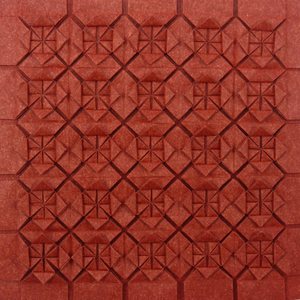John Lackland Tessellation


I derived this model from Her Majesty’s Tessellation by removing most of the free spaces (“land”) between molecules. Each molecule is still 6×6 grid units. Folded from the rare red Elephant Hide paper.
Some time after designing this model, I came to the conclusion that Shuzo Fujimoto was probably the first to come up with this design. His original books often show only back-lit pictures of tessellations, and in low quality, which makes it difficult to tell for sure how a design is structured. At first, I thought some pictures show this very design. After looking at them in more detail, I became convinced that they actually show a design identical to Ilan Garibi’s Red Flower Tessellation. However, there is a design shown right next to that one which looks like John Lackland Tess but with an extra petal fold on each petal of the “flower”. This shape can’t be achieved starting directly from Red Flower, so now I think that Fujimoto did not publish John Lackland as a separate design, but must have arrived at it as an intermediate stage while folding that design. If you’re interested, the pictures in question can be found in Twist Origami I (page 33) and Invitation to Creative Playing with Origami (pages 163 and 165). [Update]: After all, I think Fujimoto may have arrived at this pattern, but it’s far from certain. The design which is to be found in his books, mentioned above, CFW 55, uses a petal fold, and there is no picture of a version with just a flat valley fold. Given that when I came up with John Lackland tess, I did not think of using a petal fold, I assume the same for Fujimoto but the other way around. He may have had the idea, but unless there is some proof he actually had, it would be just speculation to assume so.
After my publication, the same design appeared under the name Flower in the square on folduction’s Instagram channel.
Comments